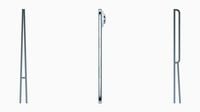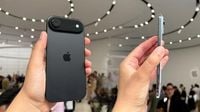Apple’s annual fall event has always been a spectacle, but this year’s “Awe Dropping” showcase on September 9, 2025, carried an extra charge of anticipation and controversy. At the heart of the event was the unveiling of the iPhone 17 lineup, a family of four new models that included the much-rumored, ultra-slim iPhone 17 Air—a device Apple proudly called its “thinnest iPhone ever.” Alongside the phones, the company also rolled out fresh iterations of the Apple Watch and AirPods, but it was the new iPhones, and especially the Air, that dominated conversation both inside and outside the tech world.
The iPhone 17 series marks a pivotal shift for Apple, both in design and in strategy. The four new models—the iPhone 17 ($799), iPhone 17 Air ($999), iPhone 17 Pro ($1,099), and iPhone 17 Pro Max ($1,199)—are available for pre-order and will hit stores on September 19. Each model comes standard with 256 gigabytes of memory, a notable bump from previous generations. Apple’s latest silicon chips, the A19 and A19 Pro, power the lineup, promising a leap in processing speed and AI capability. According to Apple, the iPhone 17 Pro Max now boasts the longest battery life of any iPhone, while the entire series features a dual-lens camera system, highlighted by a new ultra-wide 48-megapixel camera and an updated front camera that allows users to take landscape selfies without rotating the device.
But it was the iPhone 17 Air that stole the show—and sparked the most debate. At just 5.6 millimeters thick, it’s not only Apple’s thinnest iPhone, but also slimmer than the company’s own M4 iPad Pro. The Air is crafted from recycled titanium, offering three times the scratch resistance of previous iPhone glass and coming in black, white, gold, and blue. Inside, Apple engineers had to rethink the entire layout to fit all the necessary chips and sensors, resulting in a precision-milled interior that’s as much a feat of engineering as it is a statement of design philosophy.
Under the hood, the iPhone Air is powered by the A19 Pro chip, which Apple touts as the fastest CPU in any smartphone. A new 5-core GPU, loaded with neural accelerators, is designed to handle demanding AI workflows—Apple even likened its performance to “MacBook Pro levels of compute, in an iPhone.” The Air also debuts Apple’s N1 chip for WiFi 7, Bluetooth 6, and Thread, promising better Personal Hotspot and AirDrop features, and a C1X chip, a faster modem than its predecessor.
Yet the Air’s radical thinness comes with trade-offs. Most notably, the device features just a single 48-megapixel “Fusion” camera system, which combines main and telephoto lenses in a horizontal bar across the top—a sharp departure from Apple’s traditional corner-mounted, multi-lens setups. While Apple insists that the Fusion camera excels in low light and that AI-driven “machine learning” will compensate for the lack of additional lenses, many longtime users are skeptical. As Mashable’s Chris Taylor put it, “You don’t have to be a tech guru to equate more lenses with better camera quality. That’s why the Pro version has three lenses! Even the basic iPhone 17 has two.”
The Air does, however, offer some innovative camera features. The new Center Stage front camera allows for photos in any orientation, and users can now record video using both the front and rear cameras at the same time—a boon for content creators wanting to capture both an event and their own reaction. The phone is also eSIM-only, freeing up internal space and providing global coverage, though some may miss the convenience of a physical SIM card.
Battery life is another area of contention. Apple describes the Air’s battery as offering “all-day life,” but for those seeking more, there’s a new low-profile MagSafe battery that magnetically attaches to the phone, extending usage up to 40 hours. Some critics, like Taylor, argue that needing an extra $99 accessory to match the Pro’s battery longevity is a step backward: “There’s the worse battery life in the Air, which requires the bulk of an extra $99 MagSafe battery to get the same longevity as a Pro.”
The display, at least, is a clear win. The Air sports a 6.6-inch OLED panel with 120Hz ProMotion technology, a feature previously reserved for Apple’s Pro models. With 12GB of RAM and the A19 Pro chip, the Air is no slouch in performance, even if its camera and battery choices spark debate.
Apple’s broader strategy with the Air seems clear: target consumers who prize aesthetics and portability over maximum functionality, and counter rising competition from rivals like Samsung’s Galaxy S25 Edge. By creating a new category within its own lineup, Apple hopes to capture new market share among style-focused users and those who want the latest in ultra-thin tech—though not everyone is convinced the trade-offs are worth it.
Meanwhile, the iPhone 17 Pro and Pro Max double down on power. The Pro features three 48-megapixel lenses, a new Vapor Chamber for cooling, and a battery that promises up to 33 hours of video playback. The A19 chip is said to be 90% faster than the one in the iPhone 14 Pro, a claim that will surely appeal to power users and those who demand top-tier performance from their devices. However, the design has drawn criticism for its bulky new camera “plateau” and a MagSafe area that some say disrupts the phone’s aesthetic balance. “It’s a shotgun wedding between the new bulky camera plateau (double the size of the old square, with no discernible benefit) and ... whatever is going on with that credit card shape in the MagSafe area just below it,” Taylor wrote.
Color choices for the Pro models—orange and deep blue among them—have also split opinion, with some calling them bold and others, well, less than flattering. And for those hoping to avoid the new look by sticking with last year’s Pro, there’s disappointment: Apple has discontinued the iPhone 16 Pro as of this launch, leaving the 17 Pro as the only Pro option in the Apple Store.
Beyond the devices themselves, Apple also announced iOS 26, a fresh operating system that brings real-time language translation in iMessages and image identification, as well as expanded AI capabilities for developers to build new software. These moves come at a time when Apple faces mounting competition from other tech giants pushing AI-fueled software, and as the company navigates global tariff challenges that are expected to cost it more than $1 billion this quarter. Most iPhones sold in the U.S. are now produced in India, a shift made to avoid high tariffs, though recent 50% tariffs on Indian goods have complicated matters further.
In the end, Apple’s 2025 iPhone launch stands as a testament to both innovation and the sometimes-painful trade-offs that come with pushing technology forward. Whether the gamble on the Air’s thinness and the Pro’s power pays off remains to be seen, but one thing is certain: the debate over what makes an iPhone truly great is far from over.



